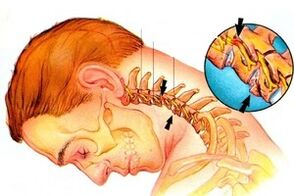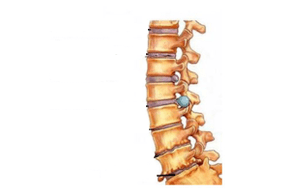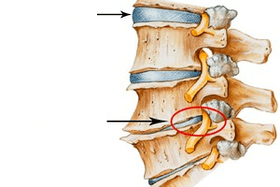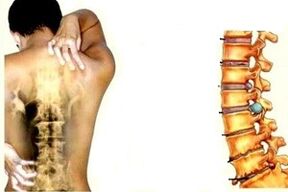
Diseases of the musculoskeletal system are one of the most common diseases of the Earth.Few people manage to avoid them completely, especially after 40 years, although experts admit that problems with the spine, muscles and joints have "younger", and many young people are increasingly complaining of pain.
The guilt of this is the lifestyle that has already met many: inaction, prolonged stay in one position (most often behind gadgets and monitors), lack of physical activity.As a result, the stand is impaired, salts and other harmful substances accumulate in the body, the functions of the musculoskeletal system are impaired and as a result the internal organs can be deformed.
Most often, osteochondrosis is detected by similar diseases, to which people are the subject of both older and quite young age and osteochondrosis with problems with the lumbosacral and cervical spine.The second most frequent type of osteochondrosis, cervical, is an unpleasant disease and, in addition - progressively, without treatment, significantly impaired lifestyle to damage.This means that it is necessary to recognize the symptoms of this disease in a timely manner and to contact an orthopedist or vertebologist in time for treatment.
How does cervical osteochondrosis develop
If a person leads a sedentary lifestyle or by virtue of his or her profession is at the same time for a long time, then the risk of meeting osteochondrosis is very high.With the development of the disease, they occur in the intervertebral discs, they deform and change their structure.
The intervertebral discs are located between the vertebrae, their job is to maintain the spine, to make it flexible and durable.There are seven vertebrae in the neck, with the help of which the head is maintained and rotated, the neck and so on.The cervical vertebrae are located very close to each other, so they are injured and displaced even by minor exercise.The risk of the disease lies in the fact that the nerve endings of the spinal nerves are affected, which is why the vessels that supply the brain to the brain are affected.The brain, in turn, does not receive vital substances and this can lead to the development of a number of other, more serious diseases that can cause damage and even death of the patient.
There are many causes and development of cervical osteochondrosis.Among the most common and common causes, the following can be distinguished:

- Impaired metabolism in the body, more special, in the cervical region, hormonal imbalance;
- salt deposition;
- low physical activity, sedentary lifestyle;
- Long stay in one posture (on the computer, the steering wheel of the car, etc.);
- malnutrition;
- Excess weight;
- neck injuries and bruises;
- Body hypothermia.
Osteochondrosis is also found against the background of chronic diseases of the musculoskeletal system, such as scoliosis or rheumatism.
In addition, osteochondrosis often leads a genetic predisposition to the body.
But whatever causes, osteochondrosis should be treated as soon as its first symptoms occur.
Signs of cervical osteochondrosis
Osteochondrosis in this spine does not always occur abruptly and unexpectedly.Most often it develops slowly and the symptoms increase over time, their number increases.The more the vertebrae and the roots of the nerves are damaged, the more noticeable the signs.
The first symptom that has to be paid is the pain of different force in the cervical spine that gives other parts of the body - the back of the head, forehead, ears, forearm, shoulder, chest, etc.In case of pain, consult a doctor to determine if it is really osteochondrosis, which is often similar to symptoms to other diseases.
Other signs of osteochondrosis
- Neck pain is exacerbated by loads or turns of the head;
- The patient experiences numbness, burning or numbness in the limbs;
- Headache and dizziness, collapse, the patient may complain of darkening and fly in the eyes, tinnitus;
- With a sharp turn of the head is probably a seizure.
Osteochondrosis is also characteristic of cervical osteochondrosis:
- coordination violation;
- heart pain;
- Vision and hearing deterioration.
Varieties of osteochondrosis
Depending on the type of pinching of the nerve and the nature of the development of the disease, doctors distinguish several syndromes:
- Spine syndrome;
- Spinal artery syndrome;
- Carden syndrome.
Root syndrome is pinching the first pairs of cervical nerve endings.The pain is felt in the neck, they are given in the blade of the shoulder, the lower back, the shoulder, the forearm.
With spinal artery syndrome, the patient experiences throbbing pain in the back of the head or temples or burning pain in the neck, the back of the head that enhances the head, during sleep, with a cough, gives it to the chest, shoulder.
In cardiac syndrome, the symptoms first look like angina, but the pain does not pass after administration of nitroglycerin, lasts for several hours and can be exacerbated by movement and deep breathing.
Symptoms of damage to specific vertebrae
The treatment of osteochondrosis is prescribed based on what the end end is damaged.There are only eight of them, each of them is above the cervical vertebra.It is possible to determine which of the vertebrae is struck by symptoms corresponding to a particular nerve spine.
Nerve end damage and characteristic pain

- The first and second department: the sensitivity of the back of the head, the pain in the parietal and dorsal region is broken;
- The third department: numbness of the neck in the area of pinching, damage to speech, sensitivity of the tongue;It happens very rarely;
- The fourth department: pain and numbness in the clavicle and/or shoulder, respiratory disorders, heart pain;
- Fifth section: shoulder pain, pain in the outer surface of the shoulder, impaired sensitivity of the limbs;
- The sixth and seventh departments: neck pain, blade, forearm, back, lower back, impaired sensitivity of the arms, fingers;The most frequent lesion;
- The eighth department: pain in the neck, back, elbow, tingling of the small toes of all limbs, bluishness of the legs and brushes due to disorders of blood circulation, lack of sensitivity to the skin and gives it to the legs.
Diagnosis and treatment of cervical osteochondrosis

To reliably the diagnosis of "cervical osteochondrosis", you should definitely consult a doctor.Many symptoms of osteochondrosis are similar to signs of other diseases, so it is important not only to start treating osteochondrosis in time, but also not to miss another pathology.
In the case of suspicion of osteochondrosis and signs of nerve endings, the doctor prescribes radiography, calculated by data failure or magnetic resonance imaging, ultrasound additional Doppler and duplex scanning.
Based on these studies, the nature of the pain syndrome and the aggregate of other symptoms, you can determine which discs are damaged and begin the necessary treatment, which will restore the affected vertebrae and nerve roots and will not allow complications of osteochondrosis to develop.
Treatment is prescribed by the doctor, it is usually complicated.First, it should relieve the symptoms of pain, which with osteochondrosis of the cervical neck are sometimes practically unbearable and spread not only to the neck but also to other parts of the body.
To do this, use painkillers in tablets, but in the case of too severe pain, non -steroidal anti -inflammatory drugs are indicated as well as warming and painkillers.
Because medicines and ointments only relieve pain and other symptoms of osteochondrosis of the neck, but do not get rid of its cause.After reducing the painful sensations of the patient, massages, physiotherapy and physiotherapy are prescribed.The patient shows a diet, medicines that improve blood circulation and maintain body function, in tablets and injections, as well as chondroprotectors that help protect and repair the tissues from the intervertebral discs.
In some cases, baths, paraffin applications, reflexology, survivotherapy are prescribed as an additional treatment for the patient.Folk methods for the treatment of cervical osteochondrosis often also quickly help to return the patient to the usual lifestyle, but they should only be used in combination with traditional methods and after consulting a doctor, as traditional medicine may have contraindications, and the use of its recipes can harm the body weakened by the body.
Complications and prevention of illness

Remember: the treatment of cervical osteochondrosis should start as quickly as possible.The longer you pull a visit to the doctor, the more difficult it will be to cure the disease, and in the meantime it can cause various complications.Osteochondrosis of the cervical spine is very dangerous because there are many blood vessels and nerve plexuses that feed the brain in this section.
Any disorder can cause problems with the blood circulation of the brain, neurological disorders, including migraines and hypertension, affect the heart, respiratory system, hearing, vision.
If osteochondrosis is started, more serious consequences in the form of brain ischemia, spinal stroke or radiculopathy are possible - a disease in which the processes are formed on the affected vertebrae, partially or completely deprive the body of sensitivity and mobility.But this is not the worst, because in severe osteochondrosis, the spinal cord is compressed, which can cause the patient's death.
Therefore, it is very important to listen to the symptoms as soon as possible and to consult a specialist who will help you return to full life.And to avoid such a disease as uterine osteochondrosis, you need to move more, do not avoid physical activity, monitor weight, eat properly and in a balanced, and also regularly visit an orthopedist or vertebologist.

























